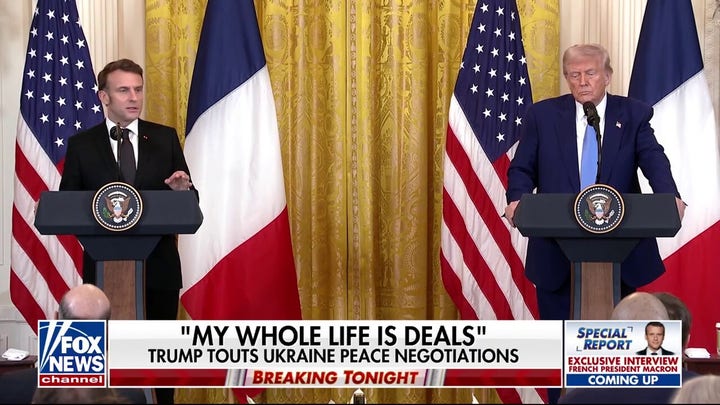On the campaign trail, President Donald Trump claimed he could end the Ukraine War in a week, and the pundits howled with laughter. But as Trump said at his press conference with French President Macron, he’s a deal guy.
In mid-February, Trump floated a plan with President Volodymyr Zelensky to develop Ukraine’s rare earth minerals. After some back and forth, Zelensky is coming to Washington now to sign the deal. It is the first step in a larger agreement to end the Ukraine war.
Trump has taken an unwinnable war, found a way to end it, and bring peace, prosperity and security to everyone.
The deal gives the U.S. access to much-needed rare earth minerals and helps us recoup some of our investment in the Ukraine war. A win for us.
It helps rebuild Ukraine’s economy and infrastructure. It puts thousands of American engineers, miners, builders and even bankers on the ground in eastern Ukraine, serving as a security guarantee to Ukraine. A win for Ukraine.
It gives the U.S. an opening to a better relationship with Russia with an aim to driving a wedge in the anti-American Sino-Russian alliance. A win for the U.S. and our allies.
It gives Russia an off-ramp to a difficult war and holds open the possibility of improved relations with the U.S., including in trade and investment. A win for Russia.
First, Trump’s plan is based on accepting reality. Because despite its best efforts and intentions, Ukraine is losing the war – slowly, grindingly, brutally – but losing, nonetheless.
President Joe Biden’s pledge to give Ukraine ‘as much as it takes, as long as it takes’ was unrealistic. This was never a war Ukraine could win. It is a war of attrition and those are won by the bigger, richer, more populous countries. Ukraine, the Europeans, and Biden never had a path to victory, the best they could do was deny Russian President Vladimir Putin a win. So, they kept fighting another forever war. Trump’s plan ends the war – with no clear winners or losers.
Second, Trump’s plan addresses the increasing frustration Americans have with the hundreds of billions of military equipment and assistance we’ve given Ukraine, a good percentage of which is unaccounted for. We could recoup some of our contributions by gaining access to Ukraine rare earth minerals and other resources, which the U.S. needs but does not have domestically.
Third, Trump’s plan pushes the Europeans into shouldering more of the burden for their own defense. In a sharp about-face, European leaders are now trekking to the White House with pledges to increase their defense budgets, to help pay for the reconstruction of Ukraine, and even to supply peacekeeping forces.
Fourth, While Ukraine cannot win the war, Ukraine could win the peace. The U.S.-Ukraine deal to develop Ukraine’s resources will put a significant number of American engineers, miners, technicians and bankers will be on the ground in Ukraine, especially eastern Ukraine, where the bulk of the resources are located.
An American economic presence will serve as a guarantor of Ukrainian independence and security, and a deterrent to another Russian invasion. Putin is not going to kill thousands of American civilians to get to Kyiv.
In some ways, an American economic presence in Ukraine is even more significant than a military presence. As we saw with Biden and Afghanistan, an American president can order the sudden withdrawal of military forces. Private American companies with long-term projects and contracts would be in Ukraine for the long haul.
Under the Trump plan, five years after the fighting stops, Ukraine could be a prosperous country, with an economy and society fully integrated with the U.S. and the West. On the other hand, Russia’s post-war prospects are bleak. No one will rush to rebuild Russia’s economy. Its energy export revenues will fall precipitously, with the lower oil and natural gas global prices brought about by Trump’s new policy of American energy dominance.
Finally, Trump’s peace plan holds open the possibility of an improved American relationship with Russia. We have had no diplomatic contact with Russia in the three years since Putin invaded Ukraine.
It gives the U.S. an opening to a better relationship with Russia with an aim to driving a wedge in the anti-American Sino-Russian alliance. A win for the U.S. and our allies.


